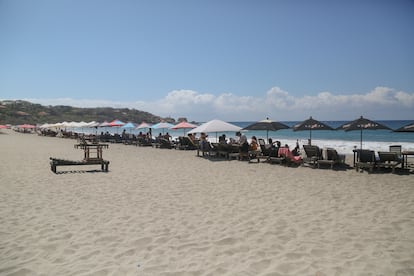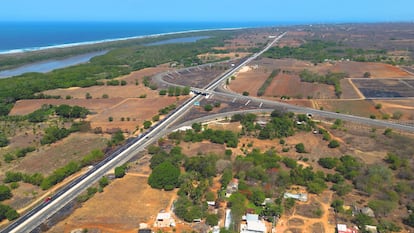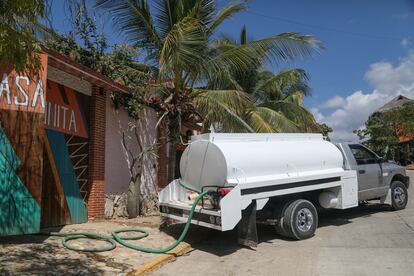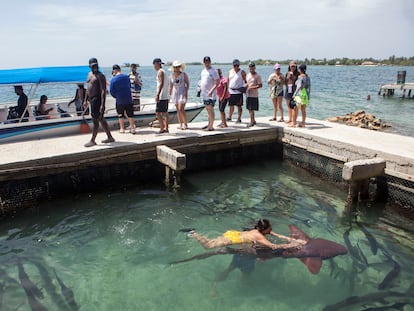Puerto Escondido: the Mexican tourist paradise that doesn’t want to be like Acapulco
Residents hope a new highway to this popular gem on the Pacific coast of Oaxaca will benefit the local population

“It was paradise back then, like a dream. The beaches were dotted with the tiny wooden houses of fishermen, and there wasn’t a soul on the sand,” said Lorenzo Castillo, remembering his childhood growing up on the beaches of Puerto Escondido, now one of Mexico’s top international destinations. From January to November 2023, this charming coastal enclave in Oaxaca, home to around 25,000 permanent residents, welcomed over 800,000 visitors.
A tropical climate, golden sand beaches lined with coconut palms, shady palapas to sit under and watch the waves crash on the shore, vivid sunsets over the Pacific... The attractions are many, but some feel mass tourism is diluting the essence of Puerto Escondido. “Puerto Angelito is packed, thanks to the influencers who drew in the crowds,” complained Castillo, a microbiologist for a private laboratory and owner of a restaurant on Marinero Beach.
Castillo is from one of Puerto Escondido’s founding families and has witnessed the gradual transformation of the fishing village located between San Pedro Mixtepec and Santa Maria Colotepec. It all began in the 1960s, when “the first surfers from the United States arrived, followed by the hippies,” said Castillo. That was the decade when Pochuteco, one of over 10 indigenous languages in the region, disappeared. “My mother was born here, my father in Pochutla. They went to Acapulco and started a family there. Although my brothers and I grew up in Guerrero, we came back here every year to visit. Then we returned for good to work and start businesses. With the pandemic everything took off — we did really well. But certain places became unbearable. Punta Zicatela at night is pure chaos, no peace and quiet at all!”
The problem, says Marta Reyes of the San Pedro Mixtepec City Council, “is that we are stretched to the limit. Puerto Escondido is very affordable and open to everyone. No judgments here — you can stroll into any eatery or bar wearing whatever you want. But we’re victims of our own success and fame.”

Recent statistics back Reyes’ claims: foreign tourists in 2022 soared by nearly 145% compared to 2021, according to Oaxaca government data. “After the pandemic, a lot of folks just decided to stick around here for good,” she noted.
“Everything changed after that. A lot of local folks felt the economic impact, and foreigners swooped in to buy land. Rents shot up a lot,” said Rosalinda Ramírez, who has a small eatery at Zicatela Beach, which put the town on the international surfing map. Reyes said the pivotal year was 2022, when construction spiked by 400%, marking the start of true gentrification. “They’re aiming to privatize the whole coastline. Real estate companies are going wild buying up farmland, even some that wasn’t appealing before. And now, they’re even developing up on the hills and cutting down all the trees,” said Ramírez as she fried fish for her customers.
Near Ramírez’s fish shack stand enormous, unfinished and abandoned hotels. Signs close to the shore display “lot for sale” or “land available” with a telephone number. “And this is only going to get worse with the highway,” she said, referring to the latest infrastructure project inaugurated by President Manuel López Obrador.
On February 4, the president visited the region to officially open the Barranca Larga-Ventanilla highway. With an investment of over $762 million, the new federal highway shortens the nearly seven-hour trip from the state capital to under three hours. The project aims to integrate basic health and education services, reducing travel time and enhancing security for about 166,000 residents and visitors. The Oaxaca Tourism Secretariat anticipates exceeding the 5.6 million visitors received in 2023, boosting tourism and development in Puerto Escondido.

Most of the locals are happy about the new highway, including Gerónimo Villanueva, known as “El Pistachero” (the Pistachio Man, in English). “Everything will be closer,” said the 82-year-old street vendor who has been pushing his cart up and down the coast for 50 years. “Get your sweet potatoes, pistachios and popsicles here! Tamarind juice and candied peanuts!” he chants. “I go to all the beaches,” said Villanueva, who has seen all the changes in the area. “It was all just dirt, from Acapulco to Oaxaca. But once they put in the road, it made things a whole lot easier for us,” he said. Roads built in the 1960s opened up Acapulco for business and linked the Guerrero coast to Puerto Escondido for the first time. “It was great! More people began coming, and I started selling more.”
“The highway to Acapulco facilitated logistics and transportation, reducing supplier costs and enhancing services,” said Lorenzo Castillo. “Acapulco used to be a weekend destination, but then turned into a day trip. That’s exactly what’s happening in Puerto Escondido. But it’s a shame how the place is being developed — everything is planned on the fly,” he added. He fears that his town will turn into another Acapulco. “The day after the new highway opened, it was super busy. I went through a whole month’s worth of food at my restaurant in just one day!”
An unsustainable future
“The growth is chaotic,” said Reyes, who explained that they lack critical infrastructure, regional plans and sufficient budgets. “Over 50% of the residents lack proper sewage, while only a few have access to potable water. Utilities only reach some areas, and the tanker truck only comes once a week to deliver water,” added Castillo, a water quality expert.
Until last year, Castillo led a clean beach committee dedicated to environmental management. Local organizations, along with NGOs like Salvemos Puerto Escondido, Costa Unida and SOS Puerto, have been advocating to halt real estate projects by foreign investors and ensure clean water access. Last year, Mexico’s Federal Committee for Protection from Sanitary Risks (COFEPRIS) warned of high bacteria levels at the Puerto Angelito and Bahía Principal beaches from lagoon pollution flowing into the sea.

“Sewage discharge in Puerto Escondido has been a long-standing issue. Garbage from upper basins flows into storm drains and is washed into the sea by the rain,” said Reyes, who believes the situation is increasingly critical. Residents and activists complained about ecological damage in Punta Colorada, Puerto Escondido’s last undeveloped beach. The governor of Oaxaca visited, promising to upgrade inadequate wastewater treatment plants. Protests and legal actions halted a risky urban development that threatened the sand dunes, jungle and forest ecosystem, endangering protected species along the coastline.
“I trust that the state authorities will do something quickly. And that they will resolve the garbage dump problem,” said Reyes, referring to the Pedro Mixtepec municipal landfill. “It’s an overflowing, open-air dump — it’s so dangerous for our health. And there are no programs in place for solid waste management.” There is also no municipal road planning. “We need that more than ever with all the heavy vehicles coming in on the new highway. We really need support from the federal government because it feels like we’re drowning here,” said Reyes.
Castillo wants more investment in infrastructure for basic services. “But, above all, we need a management plan,” he said, with sustainable methods to efficiently use resources “so we don’t end up like Acapulco. That’s where we’re headed without any planning.” Reyes agrees: “Tourism is welcome, but without putting our natural resources or the environment at risk.”
The challenge is to strike a balance for sustainable tourism and foreign investment to promote local development without harming the environment and sacrificing basic rights like access to clean water. “The money tourism brings in is great for the locals, but we must find the right balance. Hurricane Otis showed us that growing without a solid plan can ruin our little piece of paradise,” Castillo said, concerned about mass tourism ruining the beaches he cherished from his youth.
Sign up for our weekly newsletter to get more English-language news coverage from EL PAÍS USA Edition
Tu suscripción se está usando en otro dispositivo
¿Quieres añadir otro usuario a tu suscripción?
Si continúas leyendo en este dispositivo, no se podrá leer en el otro.
FlechaTu suscripción se está usando en otro dispositivo y solo puedes acceder a EL PAÍS desde un dispositivo a la vez.
Si quieres compartir tu cuenta, cambia tu suscripción a la modalidad Premium, así podrás añadir otro usuario. Cada uno accederá con su propia cuenta de email, lo que os permitirá personalizar vuestra experiencia en EL PAÍS.
¿Tienes una suscripción de empresa? Accede aquí para contratar más cuentas.
En el caso de no saber quién está usando tu cuenta, te recomendamos cambiar tu contraseña aquí.
Si decides continuar compartiendo tu cuenta, este mensaje se mostrará en tu dispositivo y en el de la otra persona que está usando tu cuenta de forma indefinida, afectando a tu experiencia de lectura. Puedes consultar aquí los términos y condiciones de la suscripción digital.
More information
Archived In
Últimas noticias
Most viewed
- Sinaloa Cartel war is taking its toll on Los Chapitos
- Oona Chaplin: ‘I told James Cameron that I was living in a treehouse and starting a permaculture project with a friend’
- Reinhard Genzel, Nobel laureate in physics: ‘One-minute videos will never give you the truth’
- Why the price of coffee has skyrocketed: from Brazilian plantations to specialty coffee houses
- Silver prices are going crazy: This is what’s fueling the rally










































